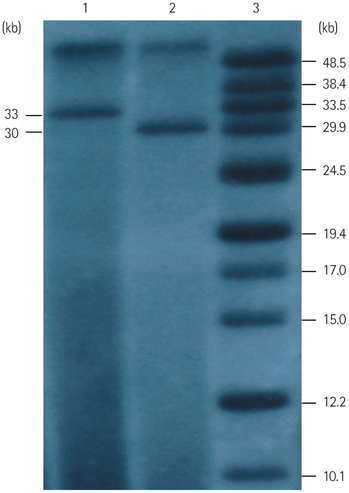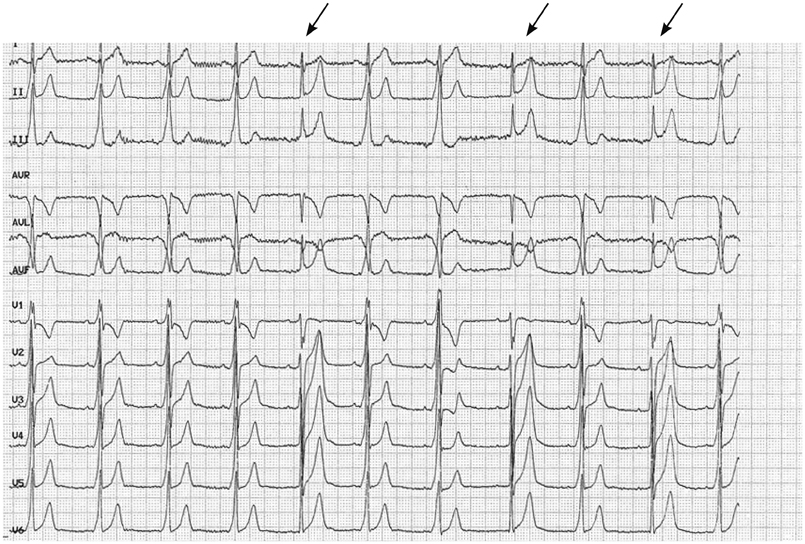Korean Circ J.
2014 Sep;44(5):348-350. 10.4070/kcj.2014.44.5.348.
Intermittent Pre-Excitation-Syndrome in Facio-Scapulo-Humeral Muscular Dystrophy
- Affiliations
-
- 1Krankenanstalt Rudolfstiftung, Vienna, Austria. fifigs1@yahoo.de
- 2Second Medical Department, Krankenanstalt Rudolfstiftung, Vienna, Austria.
- 3Institute of Human Genetics, University Hospital Magdeburg, Magdeburg, Germany.
- KMID: 2223875
- DOI: http://doi.org/10.4070/kcj.2014.44.5.348
Abstract
- Pre-excitation-syndrome has not been reported as a phenotypic feature of facio-scapulo-humeral muscular dystrophy (FSH-MD). In a 39-year-old male with FSH-MD due to a reduced tandem repeat size in the D4Z4-locus on chromosome 4q35, cardiac involvement, manifesting as an incomplete right bundle-branch-block, tall T-waves in V 3-5, ST-elevation in V 2-4, and mild thickening of the left ventricular myocardium, was first recognised 10 years earlier. Follow-up at age 39 years revealed mild myocardial thickening, two intra-ventricular aberrant bands, and, surprisingly, intermittent pre-excitation on a routine electrocardiography. Cardiac involvement in FSH-MD may manifest as hypertrophic cardiomyopathy or various arrhythmias, of which one may be pre-excitation-syndrome.
Keyword
MeSH Terms
Figure
Reference
-
1. Finsterer J, Stöllberger C. Primary myopathies and the heart. Scand Cardiovasc J. 2008; 42:9–24.2. Shigeto H, Tamura T, Oya Y, Ogawa M, Kawai M. [Facioscapulohumeral muscular dystrophy with sinus dysfunction]. Rinsho Shinkeigaku. 2002; 42:881–884.3. Stevenson WG, Perloff JK, Weiss JN, Anderson TL. Facioscapulohumeral muscular dystrophy: evidence for selective, genetic electrophysiologic cardiac involvement. J Am Coll Cardiol. 1990; 15:292–299.4. Laforêt P, de Toma C, Eymard B, et al. Cardiac involvement in genetically confirmed facioscapulohumeral muscular dystrophy. Neurology. 1998; 51:1454–1456.5. Trevisan CP, Pastorello E, Armani M, et al. Facioscapulohumeral muscular dystrophy and occurrence of heart arrhythmia. Eur Neurol. 2006; 56:1–5.6. Berlit P, Stegaru-Hellring B. The heart in muscular dystrophy: an electrocardiographic and ultrasound study of 20 patients. Eur Arch Psychiatry Clin Neurosci. 1991; 241:177–180.7. Faustmann PM, Farahati J, Rupilius B, Dux R, Koch MC, Reiners C. Cardiac involvement in facio-scapulo-humeral muscular dystrophy: a family study using Thallium-201 single-photon-emission-computed tomography. J Neurol Sci. 1996; 144:59–63.8. Kilmer DD, Abresch RT, McCrory MA, et al. Profiles of neuromuscular diseases. Facioscapulohumeral muscular dystrophy. Am J Phys Med Rehabil. 1995; 74:5 Suppl. S131–S139.9. Galetta F, Franzoni F, Sposito R, et al. Subclinical cardiac involvement in patients with facioscapulohumeral muscular dystrophy. Neuromuscul Disord. 2005; 15:403–408.10. Topaloğlu H, Celiker A, Ozme S, et al. Facioscapulohumeral syndrome with cardiomyopathy. Postgrad Med J. 1990; 66:1088–1089.
- Full Text Links
- Actions
-
Cited
- CITED
-
- Close
- Share
- Similar articles
-
- Two Cases of Oculopharyngeal Muscular Dystrophy in One Family
- Progressive Muscular Dystrophy: A Case Report
- Pneumothorax Associated with Noninvasive Intermittent Positive Pressure Ventilation in Duchenne Muscular Dystrophy: A case report
- A Case of Oculopharyngeal Muscular Dystrophy
- Multiple Pilomatricomas Associated with Myotonic Muscular Dystrophy in Brother and Sister



